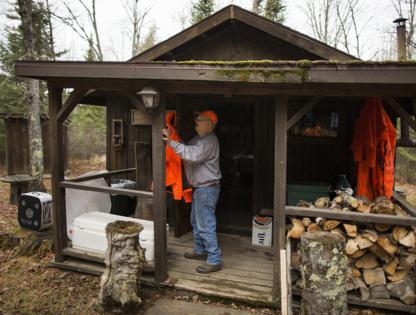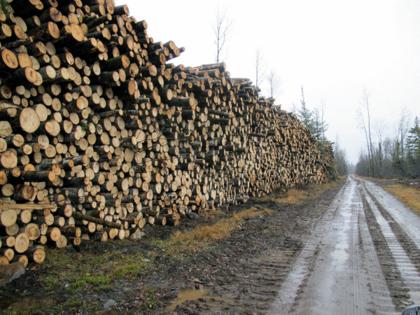Dennis Anderson: On eve of Minnesota deer season, logging takes a toll on northern whitetails
Published in Outdoors
MINNEAPOLIS — Minnesota’s North Woods are being sold to the state’s timber products industry, and deer and deer hunters will pay the price with lower populations and lower harvests for years to come.
Ruffed grouse populations also are at risk, as are less visible forest species such as fishers and martens, woodpeckers and songbirds.
The culprit? Minnesota Department of Natural Resources forest management policies that allow too much aspen and other tree species to be cut too early.
“And I don’t see a lot of hope that things will improve, unless the public and the Legislature get involved,” said Tim Quincer.
Quincer retired from his job as a DNR forest wildlife manager in September. He has a degree in wildlife management and has hunted deer and grouse his whole life. He’s speaking out because he believes his former employer is satisfying the wood products industry at the expense of the state’s forests and forest wildlife.
A primary problem with Minnesota forest management, Quincer said, is that loggers are allowed to cut aspen in 40-year rotations, whereas significant wildlife benefits don’t begin for 60 years or longer.
That’s when understories of spruce, fir and white cedar take hold in aspen stands, which benefit deer and other forest wildlife.
“Forestry management is complex,” Quincer said. “But some hunters are starting to take notice about what’s happening up north when they see a 200-acre clear-cut where they used to hunt.”
Minnesota’s firearms deer season begins a half-hour before sunrise on Saturday, Nov. 8. Whitetail prospects have been bleak in northeast Minnesota in recent years. Recent mild winters suggest deer harvests there — and throughout Minnesota — will increase this season, though perhaps not significantly.
The issue is timely because the DNR has begun formulating a new 10-year forest management plan that will take effect in 2028, and integrating fish and wildlife considerations in the new plan is critical, wildlife advocates say.
“Not all of our forest economy should revolve around ‘cords and boards,’ ” said Craig Sterle, who retired in 2012 as DNR assistant area forestry supervisor in Cloquet.
Sterle owns a hunting camp northeast of Duluth. He agrees too many trees are being cut on central and northern Minnesota state lands.
“Wildlife, hunting and tourism are also parts of the Minnesota forest economy, and we need to manage with them in mind, in addition to policies that serve the forest products industry,” he said.
A sea change in Minnesota forest management began under the administration of Gov. Mark Dayton, when the state agreed to supply 870,000 cords of wood to the forest products industry annually.
“But you can’t cut 870,000 cords and distribute your harvest spatially in northern Minnesota in ways that benefit wildlife,” Quincer said. “Our calculations were that we could probably cut 600,000 cords and achieve forest diversity that benefits both the forest and wildlife. But not 870,000.”
The larger figure set the stage for the controversy over timber cutting on state wildlife management areas (WMAs) that has roiled the DNR for six years.
In 2019, as the Minnesota Star Tribune’s Tony Kennedy has reported, 28 DNR wildlife managers wrote to Commissioner Sarah Strommen saying that timber cutting on state WMAs was not being undertaken primarily to benefit wildlife.
The U.S. Fish and Wildlife Service subsequently admonished the DNR because many of the areas were purchased at least in part with federal funds derived from hunter license sales. The transactions required that WMA logging be undertaken primarily to benefit wildlife.
Additionally, the Minnesota Legislative Auditor issued a report recently that faulted the DNR for failing to protect wildlife from WMA logging. About 12% of Minnesota state-land logging occurs on WMAs.
But wildlife is threatened by logging not only on WMAs but throughout central and northern Minnesota, Quincer said.
“The DNR used to coordinate better between its forestry and wildlife managers. It was always a compromise — no one got everything they wanted," he said. “But when the cord target was developed, it was a death knell for that process. Now DNR policy, whether it’s stated or not, is to satisfy the logging industry.”
Deer hunters often blame wolves for a lack of northern Minnesota whitetails. But wolf abundance, like deer abundance, and wolves’ predatory efficiency are entwined with forest management, a critical component of which are deer wintering areas, Quincer said.
Many of these areas, or “yards,” are populated with northern white cedar, which often is mixed with aspen. Because timber cutting “reserves’’ have been reduced to 5% — meaning, for example, in a 100-acre cut, 5% of trees must be left standing — at least some of the region’s cedar is being cut along with broader aspen harvests.
“Northern white cedar is very valuable to deer in winter because it provides cover and often is in areas where tamarack and black spruce also grow,” Sterle said. “But once you cut cedar, it’s very tough, if not impossible, to regenerate.”
In 2023, the DNR preserved a key deer wintering yard near Elephant Lake northeast of Orr, Minn. Under terms of a 21-year lease on 176 acres of School Trust Lands, DNR wildlife managers are maintaining the parcel’s conifers, such as red pine, white pine and white spruce, hoping to provide food and cover for deer during a year’s coldest and snowiest months.
The lease’s actual effect, however, might be opposite of its intention, Quincer said.
“Yes, wolves kill deer,” Quincer said. “But when the northern Minnesota forest was more intact, meaning there was less cutting going on, the aspen rotation age was longer and timber harvests were more spatially distributed. Wolves, then, also were more widely distributed, because deer were more widely distributed. Now, with fewer traditional deer wintering areas on the landscape, wolves are more effective predators. Instead of broadly distributing themselves across the landscape — like a fox going to a pheasant nest in a lone fence line — wolves often go to the relatively fewer areas where deer winter."
What do DNR forestry managers, and the forest products industry, have to say about all this?
In future columns, we’ll find out.
____
©2025 The Minnesota Star Tribune. Visit at startribune.com. Distributed by Tribune Content Agency, LLC.










Comments